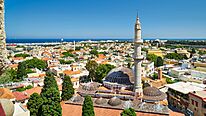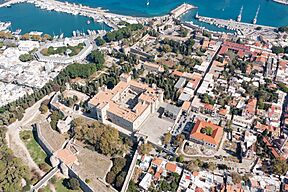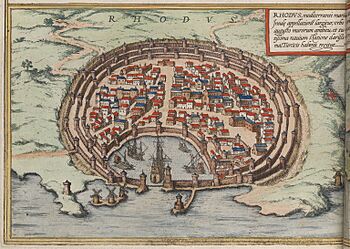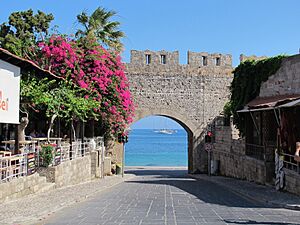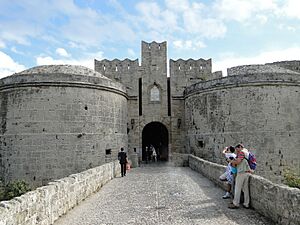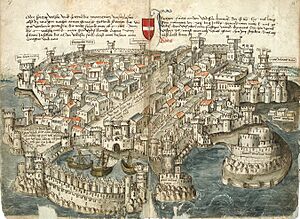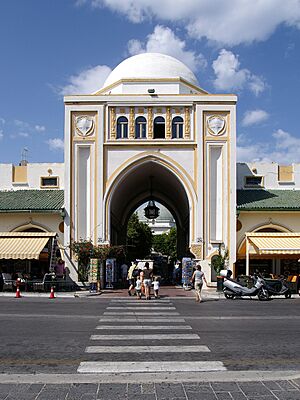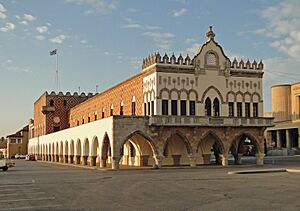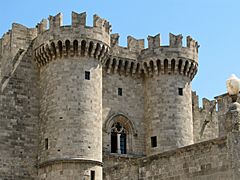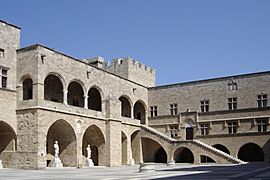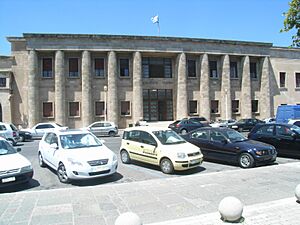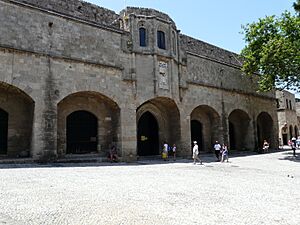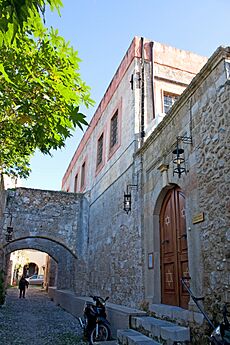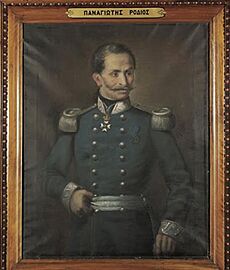Rhodes (city) facts for kids
Quick facts for kids
Rhodes
Ρόδος
|
||
|---|---|---|
|
From top, left to right: View to Rhodes and the palace, statue of Diagoras of Rhodes carried by his sons, St. Catherine gate, Eleftherios Venizelos Street with the Konstantinos Karamanlis statue, view to the mosque of Suleiman, Rhodian Deer statues in the city's port, aerial view of the Palace of the Grand Master.
|
||
|
||
| Country | Greece | |
| Administrative region | South Aegean | |
| Regional unit | Rhodes | |
| Municipality | Rhodes | |
| • Municipal unit | 19.481 km2 (7.522 sq mi) | |
| Elevation | 26 m (85 ft) | |
| Population
(2021)
|
||
| • Metro | 86,199 | |
| • Municipal unit | 56,440 | |
| • Municipal unit density | 2,897.2/km2 (7,503.7/sq mi) | |
| Demonym(s) | Rhodian, Rhodiot or Rhodiote (rare) Rhoditis (Greek) |
|
| Time zone | UTC+2 (EET) | |
| • Summer (DST) | UTC+3 (EEST) | |
| Postal code |
851 00, 31, 32, 33
|
|
| Area code(s) | 2241 | |
| Vehicle registration | PO, PK, PY | |
| Website | www.rhodes.gr | |
Rhodes (in Greek, Ródos) is a famous city located on the island of Rhodes in Greece. It's part of a group of islands called the Dodecanese. About 56,000 people live in Rhodes city, and nearly 90,000 live in its wider area.
Rhodes has been well-known since ancient times. It was home to the Colossus of Rhodes, one of the Seven Wonders of the Ancient World. The city's old fortress, built by the Knights Hospitaller, is one of the best-preserved medieval towns in Europe. Because of its amazing history, the Medieval city is a UNESCO World Heritage Site.
Today, Rhodes is a busy Greek city and a very popular place for tourists from all over the world.
Contents
History of Rhodes City
The island of Rhodes is located where Europe, the Middle East, and Africa meet. This special location has given the city and island a rich mix of cultures, buildings, and languages over many centuries. Its position on important sea routes has shaped its long and interesting past. People have lived on the island since about 4000 BC, during the Neolithic Period.
Ancient Times in Rhodes
The city of Rhodes was created in 408 BC by combining three smaller cities: Ialyssos, Kamiros, and Lindos. For 300 years, Rhodes was very successful. This was its "Golden Age," thanks to busy sea trade, skilled shipbuilders, and smart leaders.
One of the most famous things built during this time was the Colossus of Rhodes. This giant statue of the sun god Helios was finished in 282 BC. It took 12 years to build and was believed to stand near the harbor entrance. The ancient city also had a good sewage system and water supply. Sadly, a strong earthquake in 226 BC damaged the city and knocked down the Colossus.
Rhodes Under Roman Rule
In 164 BC, Rhodes became part of the Roman Empire. Even under Roman control, the city remained beautiful and became a major center for learning in arts and science. The Romans even adopted some of Rhodes' maritime law for their own shipping. You can still see signs of the Roman period in the city today. The Apostle Paul is said to have visited Rhodes during one of his journeys.
The Byzantine Era in Rhodes
During the Middle Ages, Rhodes was an important trading hub for the Byzantine Empire. It was a key stop for ships traveling between Constantinople and Alexandria. In the 7th century AD, the city was captured by Arab forces. They took the broken pieces of the Colossus from the harbor and moved them to Syria, where they were melted down to make coins.
After the Byzantine Empire was weakened in 1204, a local leader named Leo Gabalas took control of Rhodes. Later, the island was briefly taken by the Genoese before returning to Byzantine rule for a short time.
The Knights of Rhodes
The Knights Hospitallers were a group of warrior monks. They moved their headquarters to Rhodes in 1309 after leaving Cyprus. The Knights stayed on the island for the next two centuries, building strong defenses.
In 1444, a large army from the Mamluk Sultanate tried to attack Rhodes, but the Knights successfully defended the city. After the Fall of Constantinople in 1453, the Ottoman Empire grew quickly. In 1480, the Ottoman Sultan Mehmed the Conqueror sent an army to Rhodes. The Knights fought bravely and pushed back the Ottoman attack. This victory helped stop the Ottomans from invading other parts of Europe at that time.
After this victory, the Knights' leader, Pierre d'Aubusson, made the city's defenses even stronger. By 1521, Rhodes had some of the strongest walls and forts in the world. The Knights continued to attack Muslim merchant ships from Rhodes.
In 1522, the new Ottoman Sultan, Suleiman the Magnificent, led another huge attack on Rhodes. Even though the Knights were greatly outnumbered, they defended the city fiercely. In December 1522, the Knights and Suleiman made a deal. The Knights were allowed to leave the island with their belongings, and the people of Rhodes could continue to practice Christianity freely. On January 1, 1523, the Knights left, and Rhodes came under Ottoman control.
Rhodes Under Ottoman Rule
During the Ottoman period, many new buildings were constructed in Rhodes, like mosques, public baths, and large houses. The Greek people were asked to move outside the fortified city walls to new suburbs. The city continued to be an important market for farm products from the island.
The Ottomans changed many churches into mosques and turned large houses into private homes or public buildings. They adapted the existing buildings to their own style, adding things like baths and enclosed wooden balconies. This mix of Eastern and Western architecture made the Medieval Town unique. The Hafiz Ahmed Agha Library is a good example of Ottoman architecture from this time.
In the 19th century, Rhodes was the capital of the Eyalet of the Archipelago. However, as the Ottoman Empire declined, the city and its buildings were neglected. Strong earthquakes also caused damage. In 1856, a gunpowder storage area under an old church exploded after being hit by lightning. This caused a lot of damage and destroyed much of the Grand Master's Palace.
The Italian Period in Rhodes
In 1912, Italian troops took control of Rhodes and the other Dodecanese Islands. This became an Italian territory called the Italian Islands of the Aegean in 1923.
The architect Florestano Di Fausto played a big role in shaping modern Rhodes. He created a city plan in 1923 that mostly kept the walled old town as it was. He only removed buildings that had been built on the city walls during the Ottoman era. He also turned old cemeteries into a "green zone" around the Medieval Town.
At the same time, Di Fausto designed a new Italian Rhodes in the Mandraki area. He planned a "Garden City" and built important buildings along the main seafront, such as the Market, the Cathedral of Saint John, and the Governor's Palace. These buildings mixed different styles like Ottoman, Venetian, and local designs. The Italians also restored what was left from the Knights' period and rebuilt the Grand Master's Palace. They also created an institute to study the region's history and culture and improved the city's infrastructure.
Rhodes in World War II and After
During World War II, Allied planes bombed the old city of Rhodes in 1944, destroying a large part of it. After the war, the Greek government decided to protect these areas for future excavations and to safeguard certain buildings. In July 1944, Nazi authorities ordered the removal of over 1,700 Jewish people from Rhodes. Many of them tragically lost their lives.
In 1957, a new city plan was approved. In 1960, the entire medieval town was declared a protected monument by the Ministry of Culture. Later plans to widen streets in the old city were not carried out due to efforts to preserve its historical character. In 1988, the old town of Rhodes was recognized as a World Heritage Site by UNESCO, meaning it's important to protect for everyone.
Main Sights in Rhodes City
Rhodes city has many famous landmarks. Some are from ancient times, and most others are from the period when the Knights lived there.
- Grand Master's Palace (built in the 15th century)
- Street of the Knights of Rhodes, a famous street where the Knights lived
- Holy Trinity church
- La Juderia, the old Jewish quarter, including the Kahal Shalom Synagogue
- Acropolis of Rhodes, an ancient hilltop city
- Mehmet Aga Mosque
- Mosque of Suleiman the Magnificent
- Medieval walls, built in the 14th century and made stronger after attacks
- Gothic buildings in the historical upper town.
- Recent digs have found unique medieval shipwrecks in the Byzantine harbor.
- St. Francis of Assisi Cathedral, Rhodes
- Panagia tou Kastrou
Geography and Climate of Rhodes
The city of Rhodes is located at the very north-east tip of the island. It's shaped like a triangle. The city area covers about 19.48 square kilometers. It's the smallest part of the island by land size but has the most people. It is surrounded by the Aegean Sea on three sides.
Rhodes City Climate
Rhodes has a hot-summer Mediterranean climate. This means it has hot, dry summers and mild, wet winters. The average yearly temperature in the port of Rhodes is about 20.9°C (69.6°F).
| Climate data for Rhodes Port 4 m a.s.l. | |||||||||||||
|---|---|---|---|---|---|---|---|---|---|---|---|---|---|
| Month | Jan | Feb | Mar | Apr | May | Jun | Jul | Aug | Sep | Oct | Nov | Dec | Year |
| Record high °C (°F) | 20.8 (69.4) |
20.9 (69.6) |
24.6 (76.3) |
27.6 (81.7) |
36.4 (97.5) |
37.9 (100.2) |
37.4 (99.3) |
37.6 (99.7) |
34.4 (93.9) |
32.6 (90.7) |
26.8 (80.2) |
22.2 (72.0) |
37.9 (100.2) |
| Mean daily maximum °C (°F) | 16.1 (61.0) |
16.4 (61.5) |
17.3 (63.1) |
20.2 (68.4) |
23.9 (75.0) |
27.9 (82.2) |
30.9 (87.6) |
30.7 (87.3) |
28.6 (83.5) |
25.5 (77.9) |
22.0 (71.6) |
18.4 (65.1) |
23.2 (73.7) |
| Daily mean °C (°F) | 14.0 (57.2) |
14.3 (57.7) |
15.1 (59.2) |
18.0 (64.4) |
21.4 (70.5) |
25.3 (77.5) |
28.2 (82.8) |
28.4 (83.1) |
26.5 (79.7) |
23.4 (74.1) |
19.9 (67.8) |
16.3 (61.3) |
20.9 (69.6) |
| Mean daily minimum °C (°F) | 11.9 (53.4) |
12.2 (54.0) |
12.9 (55.2) |
15.7 (60.3) |
18.9 (66.0) |
22.4 (72.3) |
25.3 (77.5) |
26.0 (78.8) |
24.4 (75.9) |
21.2 (70.2) |
17.7 (63.9) |
14.2 (57.6) |
18.6 (65.4) |
| Record low °C (°F) | 2.9 (37.2) |
4.7 (40.5) |
3.8 (38.8) |
9.4 (48.9) |
14.2 (57.6) |
16.2 (61.2) |
22.4 (72.3) |
23.1 (73.6) |
18.7 (65.7) |
17.1 (62.8) |
13.3 (55.9) |
9.0 (48.2) |
2.9 (37.2) |
| Average rainfall mm (inches) | 113.6 (4.47) |
58.5 (2.30) |
44.5 (1.75) |
19.2 (0.76) |
6.5 (0.26) |
6.3 (0.25) |
0.1 (0.00) |
0.3 (0.01) |
3.0 (0.12) |
26.7 (1.05) |
87.2 (3.43) |
144.1 (5.67) |
510 (20.07) |
| Mean monthly sunshine hours | 151.8 | 184.8 | 238.8 | 269.3 | 326.8 | 374.8 | 393.5 | 363.7 | 311.8 | 260.2 | 190.8 | 157.8 | 3,224.1 |
| Source 1: Municipal Port Fund of South Dodecanese (Jan 2019-Aug 2024) | |||||||||||||
| Source 2: Sunshine Rhodes AP | |||||||||||||
| Climate data for Rhodes Airport | |||||||||||||
|---|---|---|---|---|---|---|---|---|---|---|---|---|---|
| Month | Jan | Feb | Mar | Apr | May | Jun | Jul | Aug | Sep | Oct | Nov | Dec | Year |
| Record high °C (°F) | 22.0 (71.6) |
22.6 (72.7) |
27.6 (81.7) |
30.6 (87.1) |
34.8 (94.6) |
36.2 (97.2) |
39.0 (102.2) |
41.2 (106.2) |
35.4 (95.7) |
33.2 (91.8) |
28.4 (83.1) |
23.4 (74.1) |
41.2 (106.2) |
| Mean daily maximum °C (°F) | 15.1 (59.2) |
15.2 (59.4) |
17 (63) |
20.0 (68.0) |
24.1 (75.4) |
28.3 (82.9) |
30.4 (86.7) |
30.7 (87.3) |
28.1 (82.6) |
24.5 (76.1) |
20.2 (68.4) |
16.7 (62.1) |
22.5 (72.6) |
| Daily mean °C (°F) | 12.0 (53.6) |
12.0 (53.6) |
13.5 (56.3) |
16.3 (61.3) |
20.0 (68.0) |
24.2 (75.6) |
26.4 (79.5) |
26.7 (80.1) |
24.4 (75.9) |
20.7 (69.3) |
16.7 (62.1) |
13.5 (56.3) |
18.9 (66.0) |
| Mean daily minimum °C (°F) | 9.2 (48.6) |
9.1 (48.4) |
10.5 (50.9) |
13 (55) |
16.3 (61.3) |
20.4 (68.7) |
22.7 (72.9) |
23.2 (73.8) |
21 (70) |
17.4 (63.3) |
13.7 (56.7) |
10.8 (51.4) |
15.6 (60.1) |
| Record low °C (°F) | −4.0 (24.8) |
−1.6 (29.1) |
0.2 (32.4) |
5.2 (41.4) |
8.6 (47.5) |
12.6 (54.7) |
16.8 (62.2) |
17.0 (62.6) |
10.6 (51.1) |
7.2 (45.0) |
2.4 (36.3) |
1.2 (34.2) |
−4.0 (24.8) |
| Average rainfall mm (inches) | 151.8 (5.98) |
101.7 (4.00) |
68.9 (2.71) |
29.4 (1.16) |
16.4 (0.65) |
1.8 (0.07) |
0.3 (0.01) |
0.2 (0.01) |
6.3 (0.25) |
56.9 (2.24) |
89.6 (3.53) |
152.8 (6.02) |
676.1 (26.63) |
| Average rainy days | 15.5 | 12.7 | 10.5 | 7.6 | 4.6 | 1.2 | 0.2 | 0.1 | 1.5 | 6.7 | 9.5 | 15.4 | 85.5 |
| Average relative humidity (%) | 70.1 | 69.1 | 68.7 | 66.5 | 64.4 | 58.5 | 57.6 | 59.9 | 61.4 | 67.5 | 71.4 | 72.4 | 65.6 |
| Mean daily sunshine hours | 5.0 | 6.0 | 7.0 | 9.0 | 11.0 | 13.0 | 14.0 | 13.0 | 11.0 | 8.0 | 6.0 | 5.0 | 9.0 |
| Source 1: Hellenic National Meteorological Service (1955–2010 averages) | |||||||||||||
| Source 2: NOAA (1961–1977 temperatures taken from Maritsa Airport and 1977–1990 from Rhodes International Airport), Weather Atlas (sunshine data) | |||||||||||||
| Climate data for Rhodes | |||||||||||||
|---|---|---|---|---|---|---|---|---|---|---|---|---|---|
| Month | Jan | Feb | Mar | Apr | May | Jun | Jul | Aug | Sep | Oct | Nov | Dec | Year |
| Average sea temperature °C (°F) | 17.9 (64.2) |
17.0 (62.6) |
17.1 (62.8) |
17.6 (63.7) |
20.1 (68.2) |
23.4 (74.1) |
25.9 (78.6) |
27.2 (81.0) |
26.7 (80.1) |
23.8 (74.8) |
20.9 (69.6) |
18.8 (65.8) |
21.4 (70.5) |
| Mean daily daylight hours | 10.0 | 11.0 | 12.0 | 13.0 | 14.0 | 15.0 | 14.0 | 13.0 | 12.0 | 11.0 | 10.0 | 10.0 | 12.1 |
| Average Ultraviolet index | 2 | 3 | 5 | 7 | 8 | 10 | 10 | 9 | 7 | 5 | 3 | 2 | 5.9 |
| Source: Weather Atlas | |||||||||||||
People of Rhodes
In 2011, the official population of Rhodes city was 49,541. However, it's thought that about 65,000 to 70,000 people live there permanently. During the summer, the population can reach 100,000. This is because of the many hotel beds and seasonal workers who come from other parts of Greece.
| Year | Population | Change ± |
|---|---|---|
| 1951 | 24,280 | - |
| 1961 | 28,119 | +3,839 |
| 1971 | 33,100 | +4,981 |
| 1981 | 41,425 | +8,325 |
| 1991 | 43,558 | +2,133 |
| 2001 | 53,709 | +10,151 |
| 2011 | 49,541 | -4,168 |
| 2021 | 56,440 | +6,899 |
Education in Rhodes
Rhodes offers many educational options for students:
- Primary Schools: There are 21 primary schools.
- Secondary Schools: The city has 7 high schools and 7 lyceums (senior high schools).
- Higher Education: You can find departments of the Aegean University here. There are also Higher and Lower Tourism Schools, and some private institutes.
In recent years, two private schools have also opened. They offer classes from primary to lyceum education. One of these, Rodion Paideia, is located within the city. The Music School of Rhodes is just outside the city, in Koskinou village.
Getting Around Rhodes
Air Travel
Both Rhodes city and the island are served by Diagoras International Airport. It's about 14 kilometers (9 miles) southwest of the city. The airport connects Rhodes to all other major Greek airports and to Cyprus all year round. During the busy tourist season, many international flights link the island with European cities, Israel, Egypt, and Lebanon.
Sea Travel
The city has three main ports, each with a different purpose:
- Kolona Port: Used for travel between the Dodecanese islands.
- Central Port: Serves cruise ships and international routes.
- Akandia Port: Handles domestic travel and cargo.
Ferries connect Rhodes daily with nearby Dodecanese islands, the Cycladic Islands, and the Greek mainland (Piraeus). Twice a week, a ferry also goes to Heraklion, Crete. There are also frequent routes to nearby Turkish towns like Marmaris and Fethiye. Rhodes is a popular stop for cruise ships, especially in the summer.
The city also has two marinas: a public one in downtown Mandraki and a private one next to Akandia port.
Getting Around by Land
Rhodes city has a public bus system run by RODA (blue and/or white buses). This network connects the city center to different neighborhoods. It also links the city to nearby resorts and towns like Faliraki (east) and Ixia, Ialysos, and Tholos (west), as well as the airport. The city center is also where KTEL buses (orange buses) start their routes for the island's east coast.
Taxis are easy to find in the city. You can usually find them at special taxi stands or by calling. During busy times, you might need to wait in line for a taxi.
The city's road network is mostly old, with many narrow, one-way streets. Major roads can get very busy, especially during rush hours. Parking can be difficult, especially in the city center and during market hours or the summer season. The city charges a fee for parking in some areas. The city is working on turning some empty areas near the center into parking lots to help with traffic.
A ring road exists but is not finished yet. It currently connects Rhodes Port to the Rhodes-Kallithea Avenue. Rhodes city is also the starting point for three of the island's main avenues, connecting it to Faliraki, Lindos, and the west coast (Ialysos, Airport, Tholos, Kamiros).
Media in Rhodes
Television and Radio
Most major national television channels broadcast in Rhodes city. There are also five local television stations and several local and national radio stations.
Newspapers
Two daily newspapers are published in Rhodes that cover news for both the city and the entire region. There are also other newspapers that focus on specific topics.
- I Rodiaki (meaning "The Rhodian," published daily except Mondays)
- I Dimokratiki (meaning "The Democrat," published daily except Mondays)
Sports in Rhodes
After a quiet period, sports in Rhodes city are becoming popular again. Football (soccer) and basketball are the most popular, but other sports like rugby are also growing.
Football (Soccer)
The city has two main football teams: Diagoras GS and AS Rodos. Both have played at a national level in Greece. Other city teams play in local amateur leagues.
Basketball
For the past 15 years, basketball has been represented nationally by Kolossos Rodou BC. They have played in Greece's top league, A1 Ethniki, since 2007. Other teams, past and present, include AS Diagoras Rhodes and Rodion Athlisis. Rhodes city is also home to AS Dodekanisos, a special team that plays in the national basketball league for people with disabilities.
Volleyball
Rodion Athlisis has been successful in volleyball, competing in the A2 Ethniki Volleyball league. They almost made it to the top league for two years in a row. Other city teams play at a local level.
Other Sports
Many other sports are available and growing in Rhodes. The recently formed Colossoi of Rhodes rugby team has reached the top league finals. The Nautical Club of Rhodes and Ygros Stivos of Rhodes have water polo teams. The Rhodian Tennis Club offers tennis and ping-pong. AS Diagoras Rhodes has competitive teams in cycling and track and field. You can also find martial arts like jiu jitsu, karate, and tae-kwon-do, with local teams that sometimes achieve national success.
Sports Venues
Rhodes city has three main sports venues:
- The Rhodes Municipal Stadium and the Kallipateira National Athletic Center are used for outdoor sports.
- The Municipal Indoor Hall of "Venetokleio" is for indoor sports.
The Agioi Apostoloi municipal stadium is only for football. Some clubs, like Diagoras and Rodion Athlisis, have their own indoor sports arenas. Rodion Athlisis also has a 25-meter indoor swimming pool.
Rhodes and the World
Consulates in Rhodes
The city of Rhodes is home to many foreign consulates. These are offices that help citizens of other countries.
Sister Cities of Rhodes
Rhodes is twinned with several cities around the world. This means they have special friendly relationships.
 Ávila, Spain
Ávila, Spain New Braunfels, United States
New Braunfels, United States Conches-en-Ouche, France
Conches-en-Ouche, France Gotland, Sweden
Gotland, Sweden Limassol, Cyprus
Limassol, Cyprus Perth, Australia
Perth, Australia Pisa, Italy
Pisa, Italy Puebla, Mexico
Puebla, Mexico Rhode Island, United States
Rhode Island, United States Roses, Spain
Roses, Spain Valletta, Malta
Valletta, Malta Yalta, Ukraine
Yalta, Ukraine
Famous People from Rhodes
From Ancient Times
- Diagoras of Rhodes: A famous boxer.
- Apollonius of Rhodes: A poet known for his epic poem Argonautica.
- Dinocrates: A skilled architect.
- Hieronymus of Rhodes: A philosopher.
- Panaetius: Another important philosopher.
From Modern Times
- Panagiotis Rodios: A military officer who fought in the Greek War of Independence.
- Reşit Galip: A Turkish politician.
- Oreste Lionello: An Italian actor.
- Giorgos Skartados: A football player.
- Niki Xanthou: A Greek athlete.
Images for kids
-
A copy of the famous Laocoön and His Sons statue in the Grand Master's Palace
-
A statue of Francis of Assisi in front of the St. Francis of Assisi Cathedral, Rhodes
See also
 In Spanish: Rodas (ciudad) para niños
In Spanish: Rodas (ciudad) para niños





